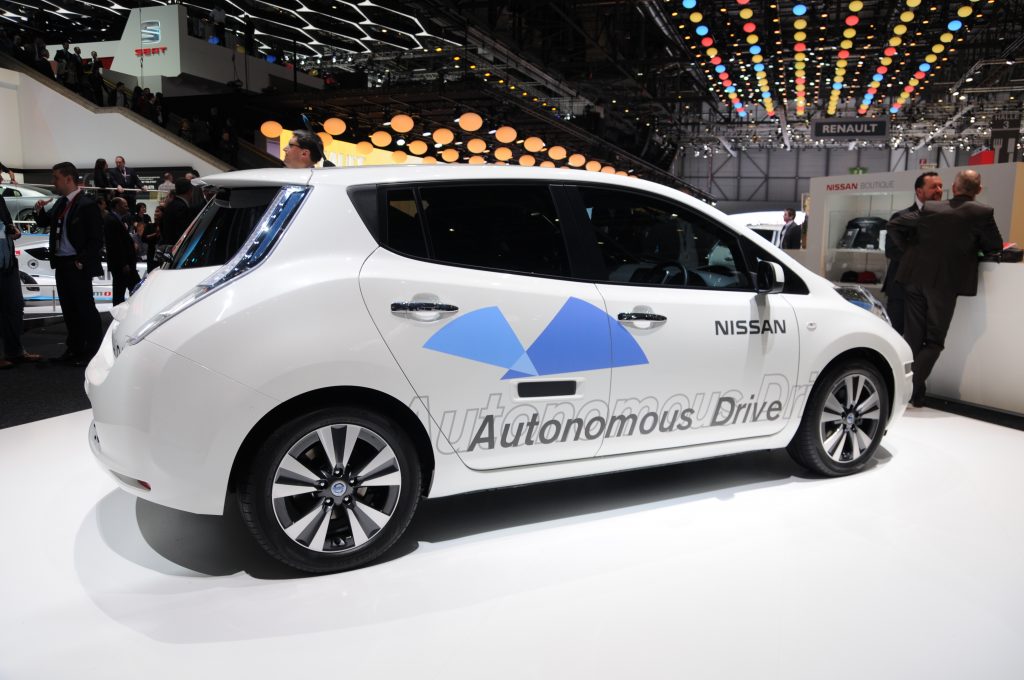I wonder, occasionally, about a world dominated by self-driving cars, sometimes called “autonomous vehicles.” GM announced in June that they’ve piloted 180 autonomous vehicles and that they’ve got the capability to begin mass production of them. For now, they’re committing $600,000,000 a year to the development.
Last year, Goldman Sachs projected that, between driver-assistance technology and autonomous vehicles, the market will grow from about $3 billion in 2015 to $96 billion in 2025 and $290 billion in 2035. One key is convincing regulators to allow vehicles that are designed with no driver controls at all, basically it would just be a comfortable chair and a computer screen in a rolling box, and to convince people to get into them.

There are three likely advantages to such devices: they would simplify our lives, they would save money and they would save lives.
Nonetheless, for many of us, the loss of control would give real pause. Few are entirely comfortable with the prospect that a machine would make and execute potentially life-and-death decisions for us. Experts foresee two particularly vexing, perhaps fatal, problems:
- The vehicles cannot react well to circumstances their programmers couldn’t foresee. Tests in Australia, for instance, show that autonomous vehicles are entirely flummoxed by kangaroos. In India drivers have so little regard for the rules of the road that the test vehicles are virtually paralyzed. I’m perversely curious, given the number of huge gaping sinkhole stories of late, of whether programmers will take “sudden conversion of the road into an abyss” into account.
- Vehicles from different manufacturers must have coordinated responses, otherwise one vehicle might “misunderstand” the likely response of the other (your Ford thinks “surely it will brake” while their Chevy thinks “oh God, accelerate!”), triggering an avoidable crash.
(A separate, fascinating question would be how autonomous vehicles will react in a no-win emergency; if you’re going to either hit and kill a single pedestrian or slam into a school bus, potentially injuring many children, which will your car choose?)
My shortest summary of the self-driving future is this: things will be smoother and more efficient so long as nothing unforeseeable happens; at that point, all bets may be off.
Which raises this question:
Are we already in a self-driving stock market?
Three quick thoughts.
-
There’s reason for concern.
Economic growth is sluggish. The stock market has been driven higher for a decade by ultra-low interest rates that discouraged investing in “risk-free” bonds and made it irresistible to borrow money to leverage a stock portfolio; that policy is now being reversed. As the Wall Street Journal recently noted, the Fed has a terrible record for managing such tightening cycles; overshoot and overreaction are far more common than a quiet drop in pressure. And stock valuations are high. If you squint just right you can claim that they’re only at 15 year highs, otherwise you describe it as one of the three highest levels in a century.
Bill Gross, bright though eccentric, argues this is “the second most crisis-laden” period since 1971 as much because there’s no plausible upside story as because of the downside risk. (Okay, if you want to be skeptical about Gross’s judgment, go to the 1:25 mark of the embedded video interview. He makes his claim then appears to have an “absence seizure” where he freezes for four seconds with his eyes bulging out; his neck moves a tiny bit so I don’t think the video froze, I think Gross did. I’d see a doctor.) In the same week, the chair of the San Francisco Federal Reserve Bank described the stock market as “running on fumes.” BofA Merrill Lynch’s “multi-asset fragility indicator” has been flashing red for months; Joe Ciolli of Business Insider quotes a BAML note to investors: “Markets today are prone to ‘flash crashes’ and tantrums …Rising fragility shows cracks emerging.”
-
There’s precious little evidence of concern.
The markets set, then broke, three record highs in June and did so with record low levels of volatility. (“Volatility has disappeared from the stock market,” notes the WSJ’s Justin Lahart, “If you think stocks are dull, look at the economy,” 6/27/2017.). Record numbers of fund managers now describe stocks as overvalued and 80% of them recognize that the US market is the world’s most overvalued.
And still it rises. Why?
-
Perhaps because robots don’t feel concern.
More money is entrusted to self-driving vehicles than ever before.
Quant hedge funds are approaching a trillion in assets, which is multiplied by the funds’ ability to use leverage to multiply their bets. John Detrixhe, who has the painfully trendy “Future of Finance”, beat at Quartz.com reports:
the buzz around quants is so intense that investment managers may feel pressured to adopt some sort of algorithmic strategy, or else risk raising less money, [Michael DePalma of Phase Capital] said. Computer-driven hedge funds have doubled their assets under management, to $932 billion, following eight straight years of inflows since 2009, according to data-tracking firm HFR. (“Even the most cutting-edge quant funds rely on old-school human intuition,” 6/28/2017)
Passive ETFs contribute another $3 trillion, and rising. Since most are indiscriminate buyers, that is, they buy both the best and the worst components of their indexes with equal aplomb, they tend to provide an increasingly important prop to the market. The Wall Street Journal’s Chris Dietrich writes:
Booming demand for passive investments is making ETFs an increasingly crucial driver of share prices, helping to extend the long US stock rally even as valuations become richer and other large buyers pare back. ETFs bought $98 billion in US stocks during the first three months of this year, on pace to surpass their total purchases for 2015 and 2016 combined…surging demand for ETFs this year had to an unprecedented extent helped fuel the latest leg higher for the eight-year stock-market rally. (“ETF buyers propel stock market’s surge,” 6/29/2017)
“The risk,” according to Michael O’Rourke, chief market strategist at Jones Trading Institutional Services, is that when the wind changes direction, “the blind buyers [might] turn to blind sellers.” Cliff Asness, pointing to the market experience in 2007, allows that “a quant quake” could happen again.
As with self-driving cars, the question isn’t whether these things will help precipitate a crash, it’s what you should do about it.
-
Remember that the bull could end with a whimper, not a bang. Optimists, such as Fed chair Janet Yellen believe we won’t see another financial crisis in our lifetime:
Will I say there will never, ever be another financial crisis? No, probably that would be going too far. But I do think we’re much safer and I hope that it will not be in our lifetimes and I don’t believe it will.
The alternative to a sudden release of pressure might be a slow release: years, perhaps decades, where stocks produce formerly bond-like returns and bonds produce cash-like returns. Jim Masturzo, senior vice president for asset allocation at Rob Arnott’s Research Affiliates, a firm responsible for $200 billion in assets, says that the firm’s asset allocation research shows that a traditional 60/40 balance portfolio is likely to return about one-half of one percent a year, once inflation is accounted for, over the next decade. That estimate assume economic growth of about 2% and a dividend yield of about 2% but also a slow decline in stock market valuations.
Jonathan Clements is both more optimistic and more pessimistic: a slow return to valuations common in the 20th century, coupled with those same growth and dividend assumptions, could yield a market return of 3-4% for a half century.
-
Try to understand the magnitude of the risk your portfolio faces.
In the last couple issues, we’ve walked folks through the mechanics of calculating your likely maximum portfolio drawdown, using your current portfolio and the maximum drawdown data based on funds’ performance during the 2007-09 crash. In the case of my own non-retirement portfolio, for example, I might anticipate a fall 30% and a recovery time in the range of 3-5 years.
-
Adjust your portfolio if you don’t like what you see.
If nothing else, rebalance your stock/bond/cash allocation if you haven’t done so in the past year or so. If you’re more ambitious and have access to MFO Premium or another database that allows you to construct a correlation matrix for your portfolio; that will tell you whether your attempt at diversification is more apparent than real. That is, if several of your funds have turned out to be highly correlated during downturns or across the entire market cycle, you might ask whether you’re better served by dropping a fund or two. That would give you a simpler portfolio that’s easier to track and assess. Your most ambitious move might be to adjust your asset allocation; our occasional essays on the charms of a stock-light portfolio show that going from 60/40 stocks-to-bonds down to 40/60 reduces your maximum drawdown by about 45% while costing you about a percent a year in returns. Slightly overweighting Europe and the emerging markets, both of which are better-valued today than the US, might offset that.
-
Consider hiring an experienced chauffeur.
Passive products excel in the sorts of steadily rising markets we’ve seen in this long bull market: with little discrimination between good and bad firms, everything rises and ETFs capture those rises efficiently. At best, they’ll capture any fall with equal efficiency. At worst, some oddity in their construction will cause them to become unhinged (as they did during the “flash crash”) or the purity of their decline will cause you to become unhinged. In either case, you’d be better served by an experienced manager who’s profited from crises before and who currently has the cash on hand to take advantage of any cracks in the system. We call those folks The Dry Powder Gang and we’ve written about them frequently.
There is, as many have noted, no such thing as passive investing. You make active decisions about what slice(s) of the market to pursue, index designers make active decisions about which companies qualify, fund issuers make active decisions about which indexes (there are now literally millions available) to track.
This might be a particularly opportune moment to assert control over your portfolio and to review the easy assumptions bred by a long bull market. If you think now about how you judge the market’s remaining upside prospects against its downside ones and how you can best preserve the gains you’ve already made, you’ll enter the fall with much better prospects.










